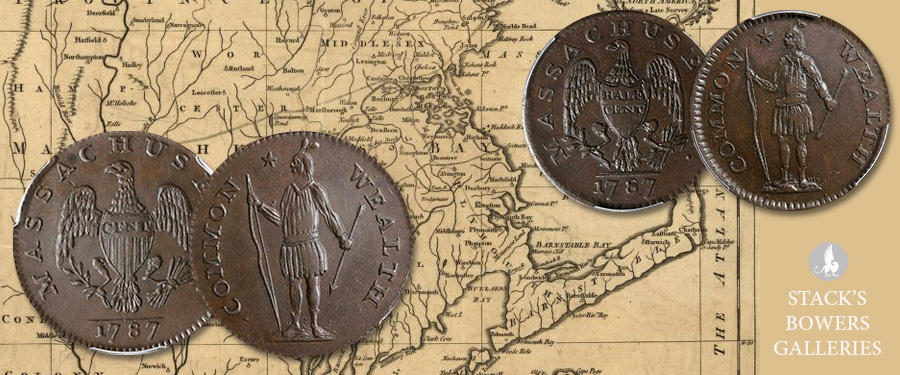
The casual substitution of “penny” for “cent” by American consumers is so ubiquitous that there’s no sense in trying to correct anyone who calls our national one-cent coins by the name of their British predecessors. Cents are pennies now. With the terms so thoroughly conflated, it’s hard to imagine a time when the distinction mattered, but in the 1780s it was meaningful. Today we’re going to take a very brief look at the first use of the “cent” denomination on American coinage, the Massachusetts coppers of 1787-1788.
After the Revolution, the newly independent states grappled with the financial fallout from the conflict, producing coinage as a circulating medium of exchange and an expression of sovereignty. The second Massachusetts mint was unusual among post-Revolution state minting efforts, in that it was a public enterprise, authorized by the state legislature on October 16, 1786. In its short life it struck copper coins denominated half cent and cent in accordance with a 1785 Federal resolution decimalizing the Spanish milled dollar.
The half cents and cents share a design, with a standing Native American holding a bow in one hand and an arrow in the other on the obverse, a motif derived from the State Seal. A heraldic eagle with wings spread, clutching an olive branch and a cluster of arrows, appears above the date on the reverse, encircled by “MASSACHUSETTS.” The denomination appears in incuse lettering at the top of the shield on the eagle’s breast; one variety of the cent is known with the denomination rendered with raised letters.
These coins are, according to many numismatist historians, the first coins struck in the United States to bear the denomination “cent.”
Two notable engravers, Joseph Callender and Jacob Perkins, worked on Massachusetts cents and half cents. Callender was based on State Street, the same street where Stack’s Bowers Galleries just opened a new gallery.
The coins were not, in the late 1780s, economical to produce. When production stopped in January 1789, their face value was eclipsed by production costs. An audit found that the copper coins’ cumulative face value was less than half of the expense to produce them. Their cost notwithstanding, the coins spent decades in circulation and were fairly popular.
Counterfeit Massachusetts cents and half cents were produced, of lighter weights than the authorized coinage, likely at Machin’s Mills. Interestingly, examples of counterfeit 1787 Massachusetts cents were used as planchets for 1788 Connecticut coppers, as they were comparable in weight to the official Connecticut issues.
The Massachusetts legislature officially closed the mint on Nov. 17, 1788, but operations continued until the facility ran out of copper and it fully shuttered on January 23, 1789. The Constitution went into effect later that year, ending any further state coinage and closing an important chapter in early American numismatic history.
We’re offering an example of each Massachusetts denomination in our Winter 2022 Showcase Auction in lot 3117 and lot 3118.





